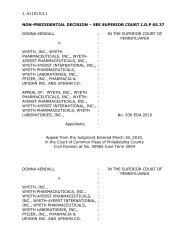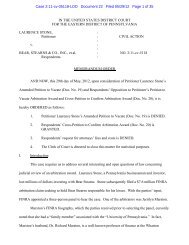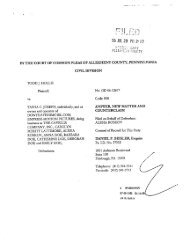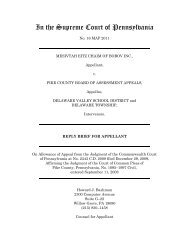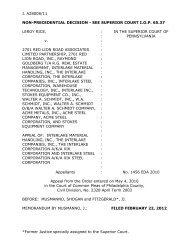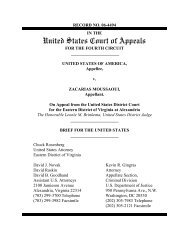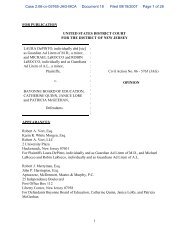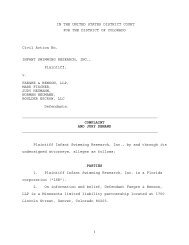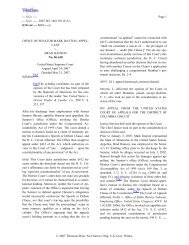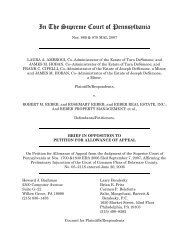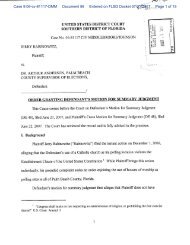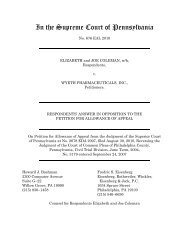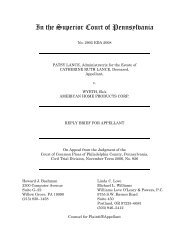petition for rehearing en banc - How Appealing
petition for rehearing en banc - How Appealing
petition for rehearing en banc - How Appealing
You also want an ePaper? Increase the reach of your titles
YUMPU automatically turns print PDFs into web optimized ePapers that Google loves.
sis “invades the fact-finding function, which in a criminal case the law assigns solely to the<br />
jury.” Carella, 491 U.S. at 268 (Scalia, Br<strong>en</strong>nan, Marshall & Blackmun, JJ., concurring) (in-<br />
ternal quotations and brackets omitted).<br />
3. The panel also stated in passing that the governm<strong>en</strong>t’s “closing argum<strong>en</strong>ts[] focused<br />
on whether the abs<strong>en</strong>ce of a writt<strong>en</strong> cov<strong>en</strong>ant was merely an oversight or instead proof of pe-<br />
cuniary fraud.” Slip op. at 13. The jury, of course, was required to follow the court’s in-<br />
structions irrespective of whatever the governm<strong>en</strong>t argued. In fact, however, the governm<strong>en</strong>t<br />
consist<strong>en</strong>tly urged from the beginning of the trial through the summations that “honest ser-<br />
vices” provided an alternative, and easier, path to conviction based on mere non-disclosures.<br />
Indeed, although the Supreme Court ev<strong>en</strong>tually ruled on broader grounds, its original grant<br />
of certiorari in this case resulted from the governm<strong>en</strong>t’s successful insist<strong>en</strong>ce at trial that no<br />
pecuniary harm need ev<strong>en</strong> be contemplated <strong>for</strong> conviction under its nondisclosure theory.<br />
The trial record convincingly shows that the governm<strong>en</strong>t treated the non-disclosure theory as<br />
a stand-alone basis <strong>for</strong> conviction, but it should suffice <strong>for</strong> pres<strong>en</strong>t purposes to note that the<br />
governm<strong>en</strong>t’s rebuttal summation emphasized one last important plea: “[W]h<strong>en</strong> you go back<br />
to the jury room, ladies and g<strong>en</strong>tlem<strong>en</strong>, I have one request. Wh<strong>en</strong> you consider the transac-<br />
tions in this case, think of those two words. Think of honest services.” Tr. 15143-44.<br />
B. There Is More Than A Reasonable Possibility That The Legal Error<br />
In The Fraud Instruction Affected The Closely Intertwined Obstruction<br />
Conviction.<br />
The obstruction statute requires the governm<strong>en</strong>t to show that the def<strong>en</strong>dant corruptly im-<br />
peded some underlying “official proceeding” that was th<strong>en</strong> p<strong>en</strong>ding or that he reasonably<br />
contemplated. This includes not only a “wrongful int<strong>en</strong>t” but also a “nexus”: To “convict a<br />
def<strong>en</strong>dant of obstructing justice under [18 U.S.C. § 1512(c)(1)], ‘the [obstructive] act must<br />
have a relationship in time, causation or logic with the judicial proceedings.’” United States<br />
v. Matthews, 505 F.3d 698, 707-08 (7th Cir. 2007) (second brackets in original) (quoting<br />
12



